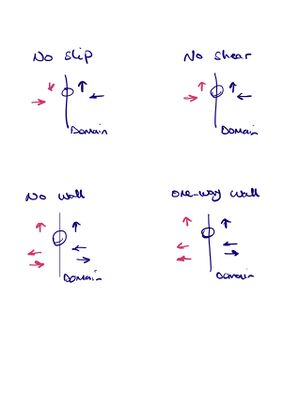Windtunnel/Boundary Conditions: Difference between revisions
Jump to navigation
Jump to search
m (+up) |
(moved from WT main page) |
||
| Line 1: | Line 1: | ||
[[Windtunnel online|up]] | [[Windtunnel online|up]] | ||
= Boundary condition for the walls = | |||
[[File:WT- Boundary Condition Skizze.jpg|thumb]] | |||
{| class="wikitable" id="ganz_oben" | |||
|+ id="Ü-id" | | |||
|- id="K-id" | |||
!colspan="3"| Boundary condition for the wall | |||
|- id="Sprungziel1" | |||
| || vx1 || vx2 | |||
|- | |||
| no-shear || zero-gradient || reflective | |||
|- | |||
| no-slip || reflective || reflective | |||
|- | |||
| no-wall || zero-gradient || zero-gradient | |||
|- | |||
| one-way wall || zero-gradient || zero-gradient & no-inflow | |||
|} | |||
= Boundary condition for the object = | |||
= Open Questions = | = Open Questions = | ||
Revision as of 08:06, 11 September 2024
Boundary condition for the walls
| Boundary condition for the wall | ||
|---|---|---|
| vx1 | vx2 | |
| no-shear | zero-gradient | reflective |
| no-slip | reflective | reflective |
| no-wall | zero-gradient | zero-gradient |
| one-way wall | zero-gradient | zero-gradient & no-inflow |
Boundary condition for the object
Open Questions
Reflective cells
Setting the vector \(\vec v_g\) in a ghost cell as \(\vec v_g=-\vec v\), with \(\vec v\) being the value in the adjacent real cell, yields \(\vec 0\) as interpolation right at the boundary. This works for plane walls. What to do in cases where a ghost cell has more than one real cell as nearest neighbor? This calls for discussion!
